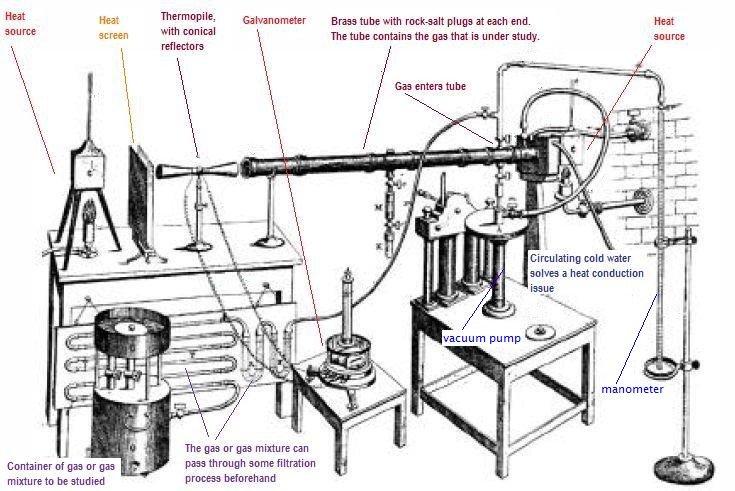John Tyndall (1820-1893) was a distinguished physicist with many interests. Although his first papers were about magnetism, explaining magnetic polarity, his papers ranged across almost every branch of physics. He also invented many scientific instruments, such as the nephelometer and turbidimeter. He was the first to create germ free air. He discovered thermophorisis. He discovered that ozone is a form of oxygen. He developed the first method of sterilization that was effective against bacterial spores that were not killed by boiling water. Among his more practical inventions were the firemen's respirator and an effective foghorn.
Of more relevance to the atmosphere and climate, he discovered the Tyndall Effect, a form of radiation scattering by colloidial suspensions.
His interest in climate began when he visited Switzerland in the summer of 1856 and became fascinated with glaciers. For the rest of his life he spent almost every summer in Switzerland, and became an accomplished mountaineer, becoming the first person to climb the Weisshorn in 1861.
Tyndall was enthralled by glaciers---how they flowed, how they changed. How they eroded landscapes and modulated river flow. Glaciers were much talked about after Louis Agassiz had published his Ice Ages hypothesis--the first indication that climate can change!
In the 1850s, it was believed that the atmosphere was transparent to infrared radiation. After all, how else would the Earth get warm? Fourier's insight that light could penetrate the atmosphere and reach the earth, which then absorbed some of it and re-radiated it as infrared radiation had been largely forgotten or discarded. (Even though Fourier didn't think the atmospheric greenhouse effect was real, he was the first to seriously discuss the idea)
Tyndall thought this was nonsense. If the atmosphere was transparent to infrared radiation, then how could Earth stay warm? Fourier had thought that outer space was not that cold. But observations of asteroids that looked like they were composed of ice contradicted that idea. If they could survive as ice bodies that close to the sun, he calculated that interstellar space had to be close to absolute zero.
So how to test this his hypothesis that the atmosphere could trap infrared radiation? In 1859 he built this apparatus:
He tested oxygen and nitrogen. Both were transparent to infrared radiation. So he then tried coal gas (mostly methane, with some carbon dioxide, carbon monoxide and water vapor). Eureka! Coal gas blocked infrared radiation as much as an inch of wood!
He also tested carbon dioxide and found that it also absorbed part of the infrared rays.
And then tested water vapor which was also avidly absorbed infrared radiation. And measured the temperature of these gases--the absorbed infrared radiation indeed warmed the gas!
This was a very important discovery. Gases could trap radiation and warm the earth!
But it was also limited. Water vapor is the greatest contributor to our present temperature deviation from equilibrium--but what of methane and carbon dioxide?
The problem was that both gases are rare. Methane is less than 2 parts per million in the atmosphere, and CO2 was less than 1/3000th of the atmosphere. In 1859 there was no way to accurately measure the concentration of such gases in the atmosphere. In fact, methane levels were too low to be detected. It was obvious that carbon dioxide must be part of the atmosphere--after all every animal exhales it. Tyndall was able to determine that carbon dioxide was present between 100 ppm and 600 ppm by pumping controlled amounts of air through a weak alkaline solution and see how much was converted to its salt, reacting with the carbon dioxide. But that margin of error told him nothing. He had no way to accurately measure carbon dioxide changing its concentration from night to day, season to season, year to year.
In 1862 Tyndall wrote this: "As a dam built across a river causes a local deepening of the stream, so our atmosphere, thrown as a barrier across the terrestrial [infrared] rays, produces a local heightening of the temperature of the Earth's surface." from Further Researches on the Absorption and Radiation of Heat by Gaseous Matter
By 1863, frustrated by his inability to measure what effect methane and carbon dioxide had on trapping infrared radiation, and recognizing that water vapor was the most important greenhouse gas (which it is) he wrote that water vapor "is a blanket more necessary to the vegetable life of England than clothing is to man. Remove for a single summer-night the aqueous vapor from the air....and the sun would rise upon an island held fast in the iron grip of frost." from "On Radiation through the Earth's Atmosphere", Philosophical Magazine pp. 204-205.

Its amazing he built that in 1859.
ReplyDeleteYes. Some aspects of 19th century science really do seem ahead of their time, or what we think of as 19th century science. Spectographic analysis was already well advanced by 150 years ago, and we were beginning to find the chemical composition of other stars--something the scientists of the 18th century thought would never be possible.
ReplyDeleteHere is an article commemorating John Tyndall:
ReplyDeletehttp://www.bbc.co.uk/news/science-environment-15093234